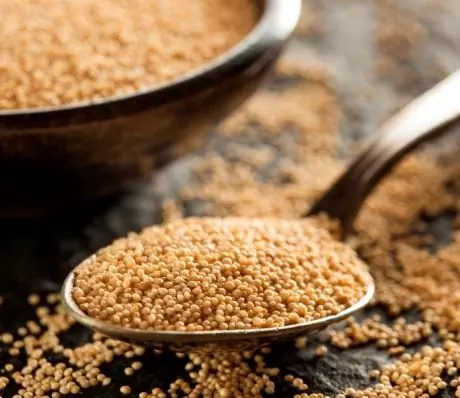- Author Rachel Wainwright [email protected].
- Public 2023-12-15 07:39.
- Last modified 2025-11-02 20:14.
Barberry
Barberry belongs to the genus of barberry shrubs. Distributed in the northern regions of Russia, as well as in the Crimea, the Caucasus, Kazakhstan, Central Asia and North America. The most famous common barberry (Berberis vulgaris) is used not only for decorative purposes. Even in Ancient Babylon and India, it was known about the healing properties of this plant - it was used to cleanse the blood. In Russia, they also knew about the medicinal properties of barberry, and used it to stop bleeding, scurvy and liver diseases.
The ratio of BJU in the product

Source: depositphotos.com How to burn 30 kcal?
| Walking | 7 minutes |
| Jogging | 3 min. |
| Swimming | 2 minutes. |
| A bike | 4 minutes |
| Aerobics | 6 minutes |
| Household chores | 10 min. |
Useful properties of barberry
All parts of this plant - roots, bark, leaves, fruits, are used in folk medicine. The fruits of barberry contain a large amount of organic acids (citric, tartaric, malic, etc.), they also contain vitamin C, pectin, carotene and mineral salts. Pectins are able to bind salts of heavy metals, salts and other unhealthy compounds, due to which barberry has a cleansing effect.
The roots, bark and leaves of barberry contain special substances - alkaloids (the main of them is berberine), in addition, tannins, vitamins E and C are present in these parts of the plant. According to the literature, it is berberine that has a stimulating effect on the muscles of the uterus, enhances the secretion of bile and has a positive effect on the amplitude of heart contractions. In addition, there is evidence that berberine helps fight tobacco and alcohol addiction.
Application in traditional medicine
Given the beneficial properties of barberry, it is often used in official medicine. In pharmacies you can buy the bark, leaves and roots of common barberry. Medicines based on this plant, used to stop gynecological bleeding, are very effective. Since alkaloids from the roots and leaves of barberry have a choleretic effect, their components are included in drugs for the treatment of biliary dyskinesia, hepatitis and other liver diseases.
Tincture of barberry (pharmacy production) is used as a sedative 25-30 drops 3 times a day.
The use of barberry in traditional medicine
Barberry juice has antipyretic, antimicrobial and hemostatic effects. In addition, it helps cleanse the blood, remove toxins from the body and slows down the aging process. Eating berries in food helps to awaken appetite, lower blood pressure and has a beneficial effect on blood circulation in the heart muscle. The fruits of the common barberry have a mild diuretic effect, help to normalize the intestines.
Jams, syrups, liqueurs, liqueurs and much more are made from barberry berries. For colds, you can use a drink made on the basis of barberry fruits. It has an antipyretic effect, removes toxins from the body and restores appetite.
Tincture of the leaves of common barberry is used as a choleretic agent for biliary dyskinesia, hepatitis. Also, an alcoholic infusion of leaves is used as a hemostatic (hemostatic) agent for uterine bleeding of various origins.
The beneficial properties of barberry allow you to use a decoction of its leaves in the treatment of peptic ulcer disease to eliminate nausea. To prepare the broth, 1 tablespoon of chopped leaves is boiled in 250-300 ml of water for 15 minutes. After the broth is infused for 40 minutes, filtered, cooled and boiled water is added (to a volume of 250 ml). Take orally a tablespoon 3 times a day.

In addition to tincture, vitamin tea can be prepared from the leaves of this plant. For this, 1 teaspoon of barberry leaves (or fruits) is taken for 1 glass of boiling water, infused for half an hour. Vitamin tea has anti-inflammatory and antimicrobial effects, astringent effects and increases appetite. This tea is good for treating gum and dental diseases.
Tincture of the bark and roots of barberry is used as a hemostatic agent in gynecology, and is also used for hypotonia of the uterus in the postpartum period. There is a pharmacy tincture (20%), which can be prescribed to stop internal bleeding.
A decoction of common barberry roots helps with hepatitis of various origins. The broth is prepared as follows: half a teaspoon of crushed roots is boiled in 250 ml of water for 30 minutes, then the broth is cooled, filtered and water is added to the original volume. Take a teaspoon 3 times a day. Such a decoction is also effective for pleurisy and bronchitis.
Barberry-based products are contraindicated for pregnant women.
YouTube video related to the article:
Found a mistake in the text? Select it and press Ctrl + Enter.






